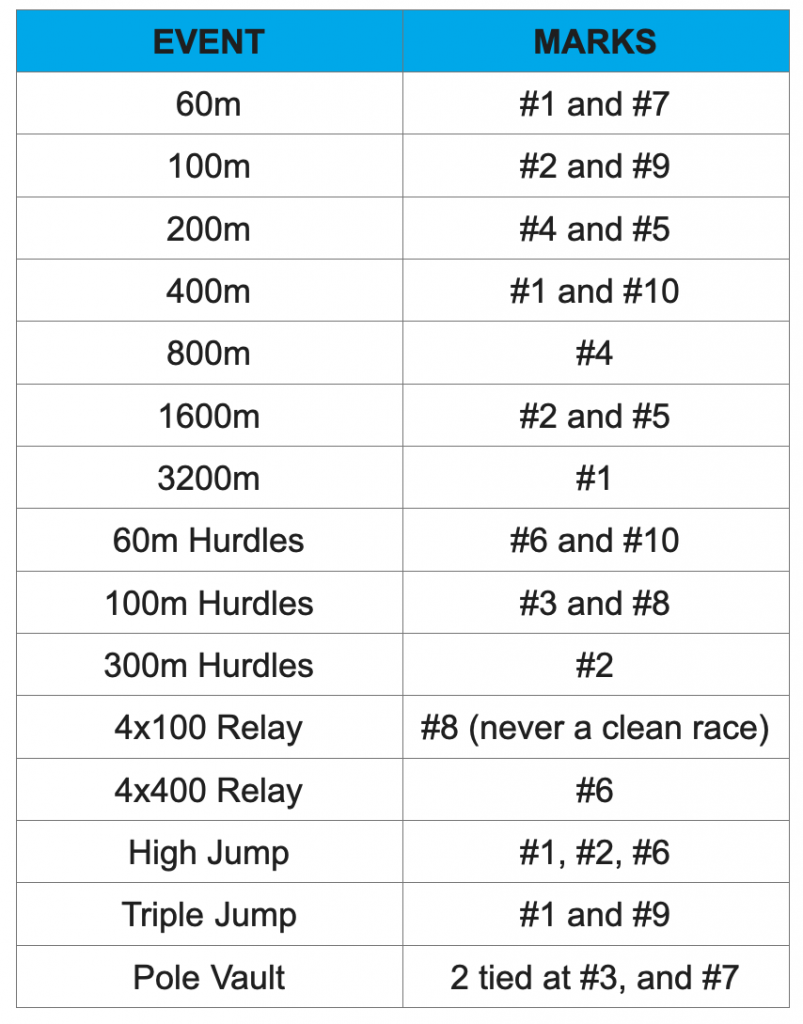
Feeding the Cats at Papillion-La Vista South
By Jerrid Johansen
I was hired as the head coach of the girls’ track and field program at Papillion-La Vista South High School (Nebraska) prior to the 2012 season. At the time I was a distance guy and all of my running experiences were in that world. I was a distance runner in high school, a XC coach, a half-marathoner, and I was one of those guys who ran 5-10 miles before school each day. The sprint group was the group that needed a coach however, so I started coaching in a world I knew very little about.
If there was an error to be made in coaching sprinters and leading a program, I made it in those first seven years. Some of my indiscretions:
- We seldomly ran at max velocity.
- We never timed anything in practice.
- We seldomly ran anything shorter than 100 meters in practice.
- We ran workouts like 12×200, 6×300, and 5×400 hill runs.
- We almost always practiced six days a week.
I have always taken my job seriously, and I was doing what I thought was best for my athletes. Clearly it wasn’t. My sprinters frequently battled leg and shin issues, which hindered our performances at the end of the year, and some of our best athletes would jump ship because they weren’t enjoying their experiences in our program. A top sprinter of ours, third-ranked in the state, was a DNS at the state meet because after walking the injury tightrope much of the season, she finally broke down after the district meet. A four-time state medalist left our program her junior year to go play tennis, a sport she had never played before in her life. Even worse, a 6-time state medalist, who was one of the best hurdlers in the state, quit the week before her junior season. She never competed for us again.
In spite of my best efforts to screw things up, we weren’t terrible… but that was because we still had great kids. In my first season, we placed fourth at state, and we finished in the top-ten three more times in my first seven years. There were also some great individual performances. We had an all-class gold medalist in the 100 hurdles and 300 hurdles, a state champion in the pole vault, and a 4×4 team that ran the seventh-fastest time in state history. Overall, we earned 33 individual state medals in the sprints, hurdles, and jumps. We medaled in both the 4×1 and 4×4 every year but one. Deep down though, I felt like something was missing from our program, and I walked away from every state track meet feeling like I was missing the mark.
Fast forward to November of 2018. My brother-in-law, who is a high school basketball coach in Texas, randomly texts me, “Check out this Tony Holler guy. I think you will like what he has to say.” I did, and the proverbial light bulb lit up in my dense little head. I immediately started researching everything I could about the Feed the Cats philosophy, and eagerly shared what I learned with my assistant coaches. Sprint maximally, recover fully, program days off, focus on the essentials, and treat your kids like racehorses? I figured it just might be crazy enough to work, and I changed our programming immediately.

2019 was the first season we were a Feed the Cats program. Our sprinters and hurdlers sprinted maximally twice a week, and everybody else (distance kids included) at least once a week. Many of our sprint practices were under 60 minutes, and the longest we ever practiced was 90 minutes (sprint and weight workouts combined). In terms of volume, the biggest workout we did was 4 x 200… although the 27-second drill always seemed to hit them a little bit differently! We practiced five days a week. And if a kid had a softball, basketball, or volleyball tournament over the weekend, I would give them Monday off. Admittedly, our first foray into Feed the Cats wasn’t perfect, but we did the best we could.
I went back and looked at our results from the 2012-2018 seasons. In those seven years we averaged fewer than six girls who could break 14.0 seconds in the 100. In 2019 we had 13 girls break 14.0 seconds. Not surprisingly, we put a bunch of marks onto our program’s All-Time Top Ten lists, which you can see below. I’m including our distance events as well because our distance coach bought into the principles of Feed the Cats and started applying them to his program as well.

As a team we won our second conference title in school history, and our JV kids made it a sweep by winning the JV conference meet. And for the first time in the 17-year history of our school, we had a track team finish on the podium at the state track meet! With over 80% of our state points returning this season, we were hopeful that we could make another appearance on the podium in 2020.

The bigger impact of Feed the Cats on our program is the impact it has had on the health and well-being of our athletes. “Happy, Healthy, and Fun” became our focus and our mantra, and it took off like wildfire. As a program, we had the most enjoyable year, and I will confidently say we had over 70 girls in our program who loved coming to practice every day. Our girls were constantly smiling and laughing, and some days I couldn’t tell if I was leading a track team, or if I was in charge of a dance troupe or gymnastics squad. Physically, they felt great. Injuries were essentially a non-issue. They wanted to be at practice. And most importantly, you could tell their mental well-being and happiness were at levels we hadn’t seen before.
We became a Feed the Cats program because I wanted my kids to be faster, and they were. One successful season, and one missed season later I understand that “fast kids” is a really nice “by-product” of this philosophy. The true value of Feed the Cats lies in its ability to produce happy and healthy kids who are having fun. That’s what we should want as adults who are leading teenagers, especially teenage girls.
+++
Follow this team @southtitantrack
+++
For more about Feed the Cats, tune into the 400 Training Debate Saturday night! SIGN UP NOW

